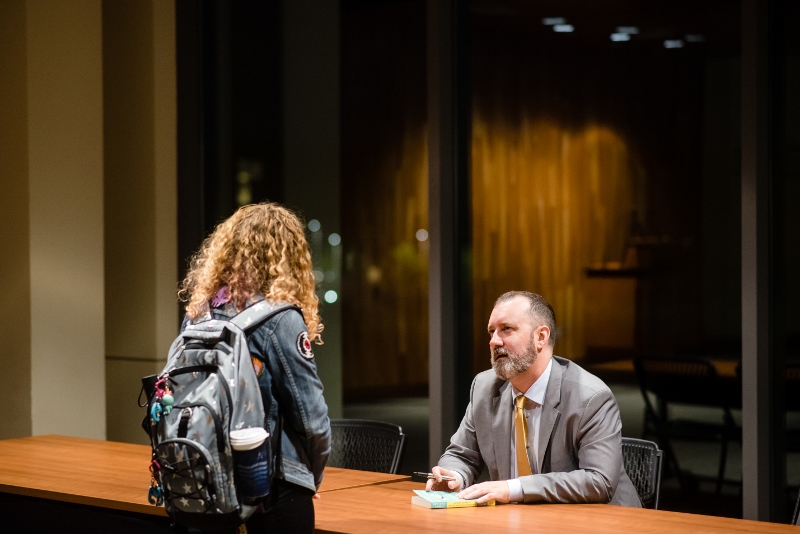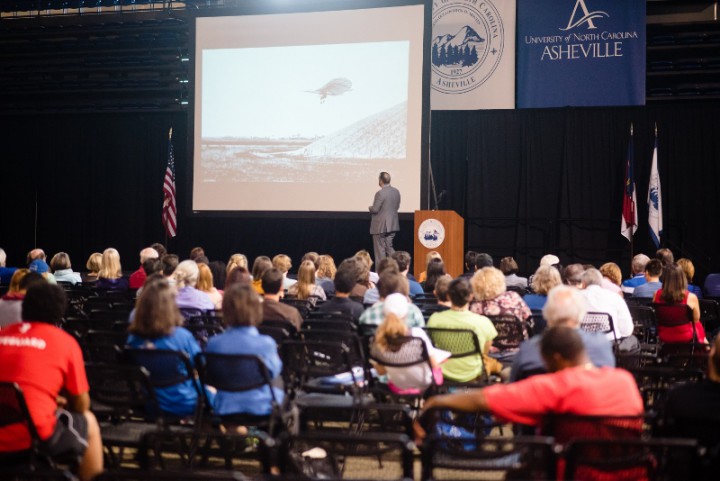Lights dimmed and chatter came to an expectant halt, when British technology pioneer Kevin Ashton was introduced in UNC Asheville’s Kimmel Arena on Aug. 23. Ashton is most widely known for co-founding the Auto-ID Center at the Massachusetts Institute of Technology, a research group that works with radio-frequency identification (RFID) and other sensing technologies. His speech contained elements of his book How to Fly a Horse, which highlights myths about the creative process by pointing out technology’s slow evolution though time.
“How did we get to here, and where are we going next?” Ashton asked at the start of his lecture. The first picture he showed on the screen behind him was of a simple stone, one of humanity’s first tools, noting that this early tool type remained unchanged for millennia. But at some point someone decided to improve the tool, which initiated a period of rapid change and growth. This, Ashton said, begs the question: Has humanity become more creative as it has evolved? It has not, he argued, saying the acceleration is only due to population growth.
“Population is the key to creation, creation is the key to population,” Ashton declared. “The reason we create is to survive.”
However, creativity has been misunderstood for centuries. He read aloud a letter ascribed to Wolfgang Amadeus Mozart, one quoted in many books and research papers, detailing Mozart’s creative routine of divine-like inspiration. But subsequent research, Ashton said, has revealed the letter to be a fake. In contrast to the inspiration model, Ashton pointed out how the Wright brothers’ looked back on their many flying failures that led to finding the right design that would stay in the air.
To get where we are today took “2,000 generations, a population of billions and everybody making a contribution,” Ashton said.
Furthering his argument, Ashton spoke of his own past experiences with creativity. While at MIT, he said he felt underqualified because his background wasn’t in any type of research, but rather in Scandinavian literature. “I felt like a complete fraud,” he said. “The Harry Potter books were just getting published at that time; this is how long ago this was. And it was like I had gone to Hogwarts, except I wasn’t a wizard.”
However, he said, it was this period that began fueling his inspiration for How to Fly a Horse. MIT’s environment had a huge impact on his view of creativity, Ashton said. “It was this environment that was genuinely creative, rather than magically creative,” he recalled. During that time, he realized [engineers] didn’t just wake up with a solution in their heads each morning, but with a determination to try over and over again.
Following the presentation, audience members participated in a Q&A session, then journeyed upstairs for a book-signing. One member in line, Taryn Hoffman, executive director of Green Side Up Foundation, said she recently read the book as part of a book club assignment. Reflecting on certain aspects of Ashton’s speech, she said, “I think at my stage of life, without failure you don’t have success, and without disappointments, you don’t have success. And things can happen in your older years that you don’t expect, but you overcome them; you have a different life, and you have a different kind of success in your life.”
Susan Reiser, a friend of Hoffman and member of the aforementioned book club, joined Hoffman in line. Reiser, a UNCA lecturer and associate dean of natural sciences, said she chose the book for their club because it had been part of UNC Asheville’s summer reading program. Many of the book’s concepts related to the creative process she teaches in conjunction with her senior computer science and engineering projects.
In addition to faculty and community members in the audience, there were students who were required to read the book as part of this year’s enrollment. Freshman Abril Ruiz-Lopez said she enjoyed the book and that it carried many applicable life lessons. “College and life is full of success and failures. You know, you’re never gonna always have success because that’s just not human,” Ruiz-Lopez said. “We’re not all perfect. We can’t [be]. Like the book says, we have to not be afraid of failing; we have to learn from our failures. Keep on going; keep trying, working on our creativity.”
Ashton’s last words to the audience touched on the subject of persistence. “You’re not as out of place as you feel,” he said assuredly. “You can either feel like an imposter or you can have a sense of entitlement. It is actually much more powerful to feel like an imposter, because there is humility in that and humility gives you the space to learn. So everybody deserves to be here; nobody is here by mistake; all you have to do now is prove it to yourself.”







Before you comment
The comments section is here to provide a platform for civil dialogue on the issues we face together as a local community. Xpress is committed to offering this platform for all voices, but when the tone of the discussion gets nasty or strays off topic, we believe many people choose not to participate. Xpress editors are determined to moderate comments to ensure a constructive interchange is maintained. All comments judged not to be in keeping with the spirit of civil discourse will be removed and repeat violators will be banned. See here for our terms of service. Thank you for being part of this effort to promote respectful discussion.